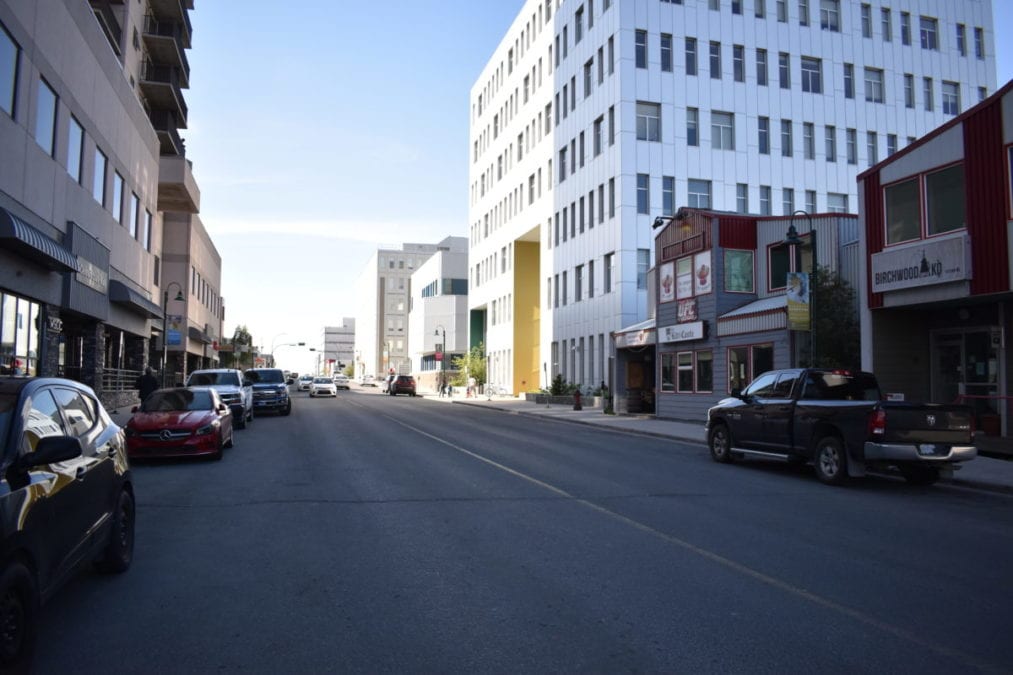NWT businesses experienced revenue losses as high as 81 per cent between April and May, according to the results of a survey released Friday by the GNWT’s Department of Industry, Tourism and Investment (ITI).
The territorial economy is forecast to contract by 3.3 per cent this year, significantly lower than the Canadian average of 8.2 per cent, as the Conference Board of Canada projected, the ITI report stated.
Two factors behind that are the mining and government sectors, which account for two-thirds of the NWT's gross domestic product. Efforts to keep those sectors moving during the pandemic are the main reasons why the territory's GDP won't be as deeply affected.

Blair McBride/NNSL photo
April and May survey
A general survey of NWT businesses conducted in April and May, when the Covid-19 lockdown measures were most heavily felt showed 81 per cent of respondents reported significant revenue decreases, with an average decrease of 63 per cent for all businesses.
The most affected businesses were in the tourism and transportation sectors. Restaurant, food, and beverage industry businesses were the least likely to indicate they could recover from the pandemic.
On average, businesses had to lay off 2.5 full-time employees and 2.6 part-time employees, with the most affected industries being restaurants, accommodations, arts, entertainment, and recreation, based on ITI analysis of survey data.
One-third of businesses reported increases in the cost of items such as materials, labour and equipment. The average increase was 22 per cent.
Although 93 per cent of businesses felt they could survive Covid, 38 per cent believed that survival would depend on how long the pandemic lasts.
The average length of time a business felt it could survive under strict lockdown measures was about five months.
Nearly half of respondents indicated they felt their business could survive another one to three months under lockdown measures and social-distancing protocols.
Many business owners stated that they needed government support to shift their operations online, as well as support to cover costs and processes related to health standards for reopening.
“While we know that the pandemic is not over yet, we are already making plans to safely restart our economy with the appropriate measures in place to protect public health, in consultation with members of the Legislative Assembly, business, and Indigenous and community governments," said ITI Minister Katrina Nokleby. "These surveys will help inform our joint planning and our continuing efforts to support and sustain the NWT economy and businesses."
According to ITI, as the territory went through the first two phases of its Emerging Wisely recovery plan, there has been a rebound in consumer and business spending.
"In fact, as the NWT economy begins to emerge from lockdown measures, the outlook for our economy is optimistic as nearly 90 per cent of businesses have reported they feel they can survive the Covid-19 pandemic," the report said.
But not all sectors will rebound at the same rate or to the same level, and tourism might be the slowest to get back to its pre-Covid status.
NNSL Media has requested more details from the government on the business rebound and is awaiting a response.
Tourism survey in March
An earlier survey conducted in March focused on tourism and gave a bleak outlook for the summer season. Even though the NWT's first confirmed case of Covid occurred near the end of March, the spread of the virus elsewhere decreased the number of Chinese travellers and saw NWT tour packages cancelled.
RELATED REPORTING: Virus-related tourism dropoff slams local businesses
Some key points of that survey included:
- 94 per cent of respondents reported decreased bookings for 2020
- More than 40 per cent stated that bookings were down by more than 80 per cent compared to 2019
- 73 per cent reported that their revenues had fallen from the year before
- 77 per cent of operators had temporarily closed
- 30 per cent had reduced their services
- 3 per cent closed permanently
- 36 percent dismissed or laid-off employees with a total of 325 employees experiencing some type of job loss
About 74,000 tourists were expected to visit the NWT between January and August, spend approximately $144,000 and contribute over $110,000 to the territory's GDP. One in 14 NWT jobs is related to the tourism sector.
Consumer survey in June
A survey covering the goods and services demanded by NWT residents, their employment status and financial capabilities was conducted in June and its data is still being compiled, ITI said.
However, initial findings show that 71 per cent of respondents are likely to travel within the NWT in the next six months, 51 per cent have increased their consumption of take-out food, 28 per cent have done more online grocery shopping and 20 percent have used delivery services more.
With regards to travel preferences, 23 per cent are now more likely than before the pandemic to travel to other parts of the NWT.
But there is some reluctance to receive tourists from outside the NWT. Only 36 per cent of respondents said they are open to tourists from other parts of Canada and only 14 per cent are ready to welcome tourists from the United States.